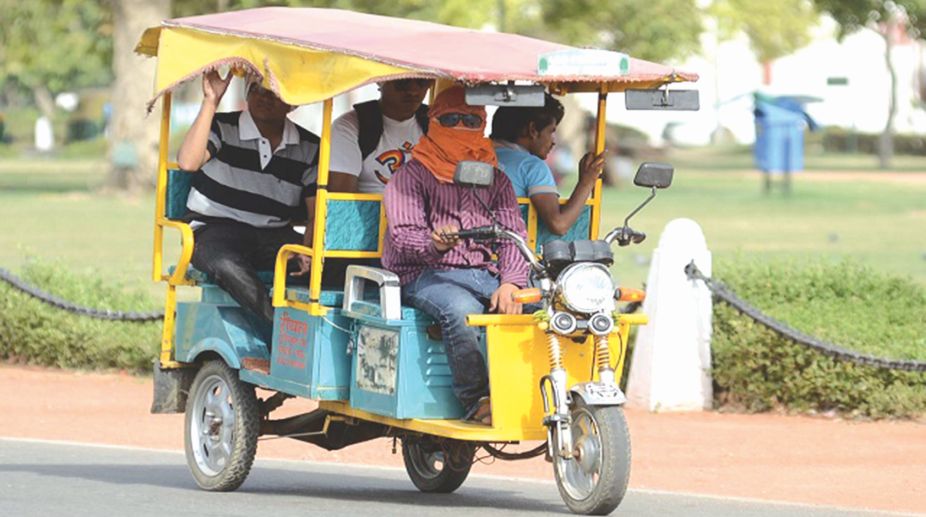Lok Sabha elections: BJP’s second list of candidates out, Khattar to contest from Karnal
Names of union ministers Nitin Gadkari and Piyush Goyal also feature in the second list of BJP's 72 Lok Sabha candidates.

Electric rickshaw.
Battery operated electric rickshaws, commonly known as e-rickshaws, are passenger vehicles powered by electricity-charged batteries. Considering their eco-friendliness and economy, they are gradually replacing petrol/ diesel/ CNG auto rickshaws.
At some places, solar powered e-rickshaws have entered the market. These rickshaws’ motors are powered by solar energy and hence they have a solar panel on the roof. In many of these e-rickshaws, the batteries, as well as the motors, are charged through solar energy.
The first design of an electric rickshaw was prepared by Nimbkar Agricultural Research Institute in the late 1990s. Nimbkar is a non-profit research and development institute based in Maharashtra.
Advertisement
Nimbkar entered the mainstream public taxi market in 2011. According to the Government’s official figures, the number of battery-operated electric rickshaws in Delhi was over a lakh in April 2012; now it is more.
In India the majority of battery-operated electric rickshaws are imported from China, the largest manufacturer of electric rickshaws across the globe. They are assembled in India.
On 31 July 2014, in response to a Public Interest Litigation, the Delhi High Court banned electric rickshaws in Delhi for safety reasons.
Union Minister of Transport, Roadways and Shipping Mr. Nitin Gadkari announced at a rally at Delhi in June 2014 that a month’s time has been given to municipal corporations to make rules governing electric rickshaws.
He said that municipal corporations would govern electric rickshaws by registering them for a nominal fee of one hundred rupees. Later, the municipal corporation, aided by traffic police, would fix the amount of fine for the contravention of rules. This policy was apparently never executed.
In 2014, Tripura took the initiative of regularising battery-operated electric rickshaws through municipal bye-laws which were called the “Tripura Battery Operated Rickshaws Rules 2014”. In March 2015, India’s Parliament legalised electric rickshaws by passing an amendment to the Motor Vehicles (Amendment) Bill, 2015.
The Modi Government in 2016 launched an ambitious scheme to distribute 5,100 battery-operated electric rickshaws to provide employment to the poor and to promote a cleaner environment.
Around 2,000 electric rickshaws were reported to be lying in Noida without anybody willing to purchase them: The Government was selling them at a higher price than the market.
To encourage the market in electric rickshaws, the Modi Government, in August 2016, exempted electric rickshaws from Section 66, sub-section 1 of the Motor Vehicles Act, 1988, thereby allowing electric rickshaws to avoid the bureaucratic hassle of getting a permit.
Nevertheless, this relaxing of a permit for electric rickshaw drivers has caused problems to the public. There have been instances of electric rickshaws causing deaths, accidents and public nuisance. In 2016, there had been some 380 fatalities in India due to electric rickshaws. Telangana topped the list with 71 deaths.
Recently, the Indraprastha Institute of Information Technology, Delhi, has started working on driverless electric rickshaws to boost last-mile connectivity. There has been news of making electric rickshaw services available on an app-based facility like Ola or Uber.
To crack down on illegal electric rickshaws in Chandigarh, the Union Territory State Transport Authority in collaboration with Chandigarh Police launched a drive to stop the plying of illegal electric rickshaws in Chandigarh.
Of late, with the advent of hydrogen fuel, there has been a new debate emerging about replacing battery operated electric rickshaws with ones powered by hydrogen fuel.
However, despite the efficiency of hydrogen-powered taxis, we lack the infrastructure of hydrogen fuelling stations and these can’t be charged at home. California, the main promoter of zero-emission vehicles, has only 15 hydrogen fuel stations.
Electric rickshaws must be regulated and/or licensed. If e-rickshaw drivers aren’t regulated, the public will be at the mercy of untrained drivers.
To sum up, the idea of switching to electric rickshaws from auto rickshaws is worthy. Electric rickshaws are more environmentally friendly and probably more cost-effective than other rickshaws and taxis. However, state or municipal governments need to regulate electric rickshaws and their drivers to make this form of transport safe.
The writers are, respectively, professor of law and a third-year law student at Jindal Global University, Sonipat.
Advertisement